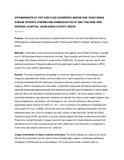| dc.contributor.author | Toroitich, John Kipserem | |
| dc.contributor.author | Oloo, Aggrey James | |
| dc.contributor.author | Arudo, John | |
| dc.date.accessioned | 2021-12-08T17:02:42Z | |
| dc.date.available | 2021-12-08T17:02:42Z | |
| dc.date.issued | 2020-09-29 | |
| dc.identifier.uri | https://doi.org/10.47604/jhmn.1144 | |
| dc.identifier.uri | https://www.iprjb.org/journals/index.php/JHMN/article/view/1144 | |
| dc.identifier.uri | http://ir-library.mmust.ac.ke:8080/xmlui/handle/123456789/1804 | |
| dc.description.abstract | Purpose: This study was conducted to establish determinants of diet and fluid adherence among ERSD patients undergoing hemodialysis at Moi Teaching and Referral Hospital- Uasingishu county. Kenya.
Methods: A descriptive cross-sectional study design was applied. Using Fisher’s formula, a sample size of 145 participants were conveniently recruited. Data collection was done by use of modified end stage renal disease adherence questionnaire (ESRD-AQ). Chi-square (χ2) was used to test statistical significance. Frequency tables and bar graphs were used for data presentation. SPSS version 22.0 was used for data analysis.
Results: The study revealed that knowledge on nutritional requirements for renal patients was marginally associated with dietary and fluid intake with a higher proportion of those with low nutritional knowledge (83.6%) adhering to diet and a relatively smaller proportion in the same category (58.9%) complying with fluid intake. A significant relationship with dietary adherence was observed where participants practiced fluid restrictions (p=0.003) and the frequency in which health staff talk about the importance of following proper diet (p <0.0001). On social support domain, a significant association was observed in patients who agreed that various social support aspects help improve depression, self-esteem, self-management, etc. and who adhered to diet scored a significantly higher mean of 5.6 (95% CI = 5.5 – 5.6) in contrast to non-adherent counterparts who had a mean of 5.5 (p = 0.0006). Among the economic factors with significant association with diet adherence were; use of bus for transport (p=0.02); income of less than KSH. 30,000 (p=0.006); treatment cost (p=0.007) and ability to access material support that helps in adherence (p=0.003). Those who claimed that lack of transport was the main reason for missing dialysis practiced fluid adherence (p=0.01) with a smaller proportion (44%) adhering to fluid restriction in comparison to 70.8% who had transport and were non- adherent.
Unique contribution to theory, practice and policy: The study findings are unique to the study site and it’s hoped that it can be used to inform hospital policy makers in addressing adherence challenges in ESRD patients on hemodialysis. The study recommends a holistic study on determinants of adherence to hemodialysis, medication use, dietary, and fluid compliance among patients undergoing HD at MTRH should be conducted in order to produce generalized results. | en_US |
| dc.language.iso | en | en_US |
| dc.publisher | Journal of Health, Medicine and Nursing | en_US |
| dc.subject | DETERMINANTS , DIET , FLUID, ADHERENCE, AMONG, END STAGE, RENAL, DISEASE PATIENTS, UNDERGOING, HAEMODIALYSIS | en_US |
| dc.title | DETERMINANTS OF DIET AND FLUID ADHERENCE AMONG END STAGE RENAL DISEASE PATIENTS UNDERGOING HAEMODIALYSIS AT MOI TEACHING AND REFERRAL HOSPITAL, UASIN GISHU COUNTY, KENYA | en_US |
| dc.type | Article | en_US |

